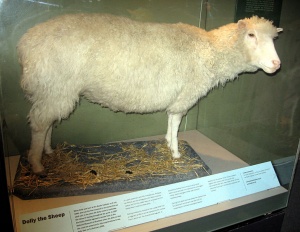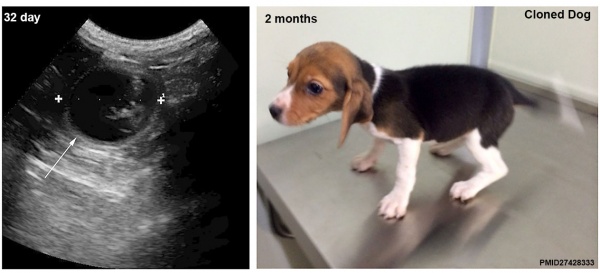Somatic Cell Nuclear Transfer
| Embryology - 27 Apr 2024 |
|---|
| Google Translate - select your language from the list shown below (this will open a new external page) |
|
العربية | català | 中文 | 中國傳統的 | français | Deutsche | עִברִית | हिंदी | bahasa Indonesia | italiano | 日本語 | 한국어 | မြန်မာ | Pilipino | Polskie | português | ਪੰਜਾਬੀ ਦੇ | Română | русский | Español | Swahili | Svensk | ไทย | Türkçe | اردو | ייִדיש | Tiếng Việt These external translations are automated and may not be accurate. (More? About Translations) |
Introduction
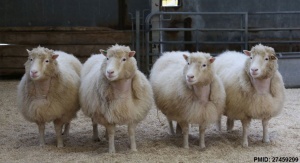
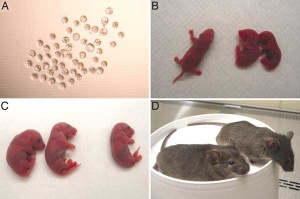
In 1996 Dolly the sheep was the first animal to be produced by somatic cell nuclear transfer (SCNT) using an adult-derived somatic cell as nuclear donor. A somatic cell refers to the fact that a cell that is not a germ cell (spermatozoa, oocyte) is used to generate a zygote from which the embryo develops. This topic is closely related to Stem Cells.
A range of different cell types has now been successfully applied to a range of species (cattle, mice, goats, pigs, cats, rabbits, horses, rats, dogs and ferrets. (see review[3])
- SCNT Links: Introduction | Stem Cells - Induced | Stem Cells - SCNT | Epigenetics | Stem Cells | ART | Fertilization | Week 1 | Category:Zygote
Some Recent Findings
|
| More recent papers |
|---|
|
This table allows an automated computer search of the external PubMed database using the listed "Search term" text link.
More? References | Discussion Page | Journal Searches | 2019 References | 2020 References Search term: Somatic Cell Nuclear Transfer | Animal Cloning |
| Older papers |
|---|
| These papers originally appeared in the Some Recent Findings table, but as that list grew in length have now been shuffled down to this collapsible table.
See also the Discussion Page for other references listed by year and References on this current page.
|
SCNT Animal Timeline
Cloned Dog (2016)[13]
Process
- Somatic nucleus cell source - culture of somatic cells from nucleus donor.
- Oocyte - nucleus and the polar body are removed from oocyte by aspiration giving an enucleated oocyte.
- Injection - of a somatic cell between the zona pellucida and the membrane of the enucleated oocyte.
- Electrofusion - Introduction of the somatic cell nucleus (and cytoplasm) into the oocyte cytoplasm.
- Embryo clone - formed by an oocyte cytoplasm and a somatic cell nucleus containing two copies of chromosomes.
- Embryo transfer - into a surrogate dam generating clone (F0) with coat colour similar to that of the nucleus source.
- Clone offspring - (F1) generated by the sexual reproduction of the clone (F0) with a normal partner.
Oocyte Enucleation
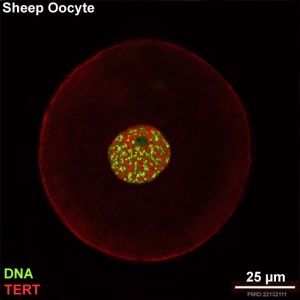
Before a somatic cell nuclei can be introduced into an oocyte, the oocyte's own nucleus needs to be removed. This process of oocyte nuclear removal is described as "oocyte enucleation". A recent study in cattle found oocyte imaging had a higher efficiency.[15]
The oocyte nucleus can be identified by:
- Hoechst staining and UV irradiation.
- Oocyte imaging.
Somatic Cell Source
A number of different tissues have been used as the somatic cell nucleus source including:
- ovarian cumulus cells
- fibroblasts
- mammary epithelium
- lymphocytes
- neural stem cells
- olfactory
- myoblasts
Epigenetics
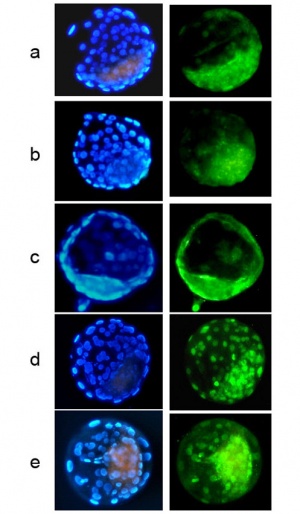
Several studies have reported that introduction of the somatic nuclei leads to deleterious epigenetic changes including DNA methylation and histone acetylation.[17][18][19]
Mitochondria
Typically mitochondria are maternally inherited and any paternal (spermatozoa) mitochondria either do not enter the oocyte or are destroyed. A recent SCNT study in pig[6] has demonstrated a mixed inheritance pattern.
Inheritance of mitochondrial DNA in serially recloned pigs by somatic cell nuclear transfer (SCNT)[6] "Somatic cell nuclear transfer (SCNT) has been established for the transmission of specific nuclear DNA. However, the fate of donor mitochondrial DNA (mtDNA) remains unclear. Here, we examined the fate of donor mtDNA in recloned pigs through third generations. ... These results indicate that heteroplasmy that originate from donor and recipient mtDNA is maintained in recloned pigs, resulting from SCNT, unlike natural reproduction."
Legislation
This technique essentially results in a clone of the original animal and therefore has been regulated by different countries in many different ways.
Australia
2010 - Cloning Legislative Review Committee Established
An independent committee has been established by the Federal Government to review cloning legislation in Australia (22 December 2010).
The independent Legislation Review Committee for the review of the Prohibition of Human Cloning for Reproduction Act 2002 and the Research Involving Human Embryos Act 2002 was announced today by the Federal Minister for Mental Health and Ageing, Mark Butler.
2006 - Prohibition of Human Cloning for Reproduction and the Regulation of Human Embryo Research Amendment Act 2006 (formerly known as the Patterson Bill) came into effect in June 2007.
2002 - Research Involving Human Embryos Act 2002 and the Prohibition of Human Cloning Act 2002 were passed by Parliament in December 2002.
USA
2012 - Human somatic cell nuclear transfer and cloning by The Ethics Committee of the American Society for Reproductive Medicine.[20]
- "This document presents arguments that conclude that it is unethical to use somatic cell nuclear transfer (SCNT) for infertility treatment due to concerns about safety; the unknown impact of SCNT on children, families, and society; and the availability of other ethically acceptable means of assisted reproduction. This document replaces the ASRM Ethics Committee report titled, "Human somatic cell nuclear transfer (cloning)," last published in Fertil Steril 2000;74:873-6."
Europe
2008 - Food Safety, Animal Health and Welfare and Environmental Impact of Animals derived from Cloning by Somatic Cell Nucleus Transfer (SCNT) and their Offspring and Products Obtained from those Animals [21] The committee included a number of recommendations in the paper.
- "At present there is no indication that clones or their progeny would pose any new or additional environmental risks compared with conventionally bred animals."
References
- ↑ 1.0 1.1 Sinclair KD, Corr SA, Gutierrez CG, Fisher PA, Lee JH, Rathbone AJ, Choi I, Campbell KH & Gardner DS. (2016). Healthy ageing of cloned sheep. Nat Commun , 7, 12359. PMID: 27459299 DOI.
- ↑ Li J, Greco V, Guasch G, Fuchs E & Mombaerts P. (2007). Mice cloned from skin cells. Proc. Natl. Acad. Sci. U.S.A. , 104, 2738-43. PMID: 17299040 DOI.
- ↑ Galli C, Lagutina I, Perota A, Colleoni S, Duchi R, Lucchini F & Lazzari G. (2012). Somatic cell nuclear transfer and transgenesis in large animals: current and future insights. Reprod. Domest. Anim. , 47 Suppl 3, 2-11. PMID: 22681293 DOI.
- ↑ Fabrèges D, Daniel N, Duranthon V & Peyriéras N. (2018). Control of inner cells' proportion by asymmetric divisions and ensuing resilience of cloned rabbit embryos. Development , , . PMID: 29567671 DOI.
- ↑ Keefer CL. (2015). Artificial cloning of domestic animals. Proc. Natl. Acad. Sci. U.S.A. , 112, 8874-8. PMID: 26195770 DOI.
- ↑ 6.0 6.1 6.2 Do M, Jang WG, Hwang JH, Jang H, Kim EJ, Jeong EJ, Shim H, Hwang SS, Oh KB, Byun SJ, Kim JH & Lee JW. (2012). Inheritance of mitochondrial DNA in serially recloned pigs by somatic cell nuclear transfer (SCNT). Biochem. Biophys. Res. Commun. , 424, 765-70. PMID: 22809505 DOI.
- ↑ Li CB, Wang ZD, Zheng Z, Hu LL, Zhong SQ & Lei L. (2011). Number of blastomeres and distribution of microvilli in cloned mouse embryos during compaction. Zygote , 19, 271-6. PMID: 20735894 DOI.
- ↑ Campbell KH, McWhir J, Ritchie WA & Wilmut I. (1996). Sheep cloned by nuclear transfer from a cultured cell line. Nature , 380, 64-6. PMID: 8598906 DOI.
- ↑ Cibelli JB, Stice SL, Golueke PJ, Kane JJ, Jerry J, Blackwell C, Ponce de León FA & Robl JM. (1998). Cloned transgenic calves produced from nonquiescent fetal fibroblasts. Science , 280, 1256-8. PMID: 9596577
- ↑ Wakayama T, Perry AC, Zuccotti M, Johnson KR & Yanagimachi R. (1998). Full-term development of mice from enucleated oocytes injected with cumulus cell nuclei. Nature , 394, 369-74. PMID: 9690471 DOI.
- ↑ Baguisi A, Behboodi E, Melican DT, Pollock JS, Destrempes MM, Cammuso C, Williams JL, Nims SD, Porter CA, Midura P, Palacios MJ, Ayres SL, Denniston RS, Hayes ML, Ziomek CA, Meade HM, Godke RA, Gavin WG, Overström EW & Echelard Y. (1999). Production of goats by somatic cell nuclear transfer. Nat. Biotechnol. , 17, 456-61. PMID: 10331804 DOI.
- ↑ Polejaeva IA, Chen SH, Vaught TD, Page RL, Mullins J, Ball S, Dai Y, Boone J, Walker S, Ayares DL, Colman A & Campbell KH. (2000). Cloned pigs produced by nuclear transfer from adult somatic cells. Nature , 407, 86-90. PMID: 10993078 DOI.
- ↑ 13.0 13.1 Lee JH, Chun JL, Kim KJ, Kim EY, Kim DH, Lee BM, Han KW, Park KS, Lee KB & Kim MK. (2016). Effect of Acteoside as a Cell Protector to Produce a Cloned Dog. PLoS ONE , 11, e0159330. PMID: 27428333 DOI.
- ↑ Barboni B, Russo V, Cecconi S, Curini V, Colosimo A, Garofalo ML, Capacchietti G, Di Giacinto O & Mattioli M. (2011). In vitro grown sheep preantral follicles yield oocytes with normal nuclear-epigenetic maturation. PLoS ONE , 6, e27550. PMID: 22132111 DOI.
- ↑ Kim EY, Park MJ, Park HY, Noh EJ, Noh EH, Park KS, Lee JB, Jeong CJ, Riu KZ & Park SP. (2012). Improved cloning efficiency and developmental potential in bovine somatic cell nuclear transfer with the oosight imaging system. Cell Reprogram , 14, 305-11. PMID: 22816525 DOI.
- ↑ Burgstaller JP, Schinogl P, Dinnyes A, Müller M & Steinborn R. (2007). Mitochondrial DNA heteroplasmy in ovine fetuses and sheep cloned by somatic cell nuclear transfer. BMC Dev. Biol. , 7, 141. PMID: 18154666 DOI.
- ↑ Zhao LX, Zhao GP, Guo RQ, Zhang D, Li XH & Zhou HM. (2012). DNA methylation status in tissues of sheep clones. Reprod. Domest. Anim. , 47, 504-12. PMID: 22039959 DOI.
- ↑ Shen CJ, Cheng WT, Wu SC, Chen HL, Tsai TC, Yang SH & Chen CM. (2012). Differential differences in methylation status of putative imprinted genes among cloned swine genomes. PLoS ONE , 7, e32812. PMID: 22393450 DOI.
- ↑ Wei Y, Zhu J, Huan Y, Liu Z, Yang C, Zhang X, Mu Y, Xia P & Liu Z. (2010). Aberrant expression and methylation status of putatively imprinted genes in placenta of cloned piglets. Cell Reprogram , 12, 213-22. PMID: 20677935 DOI.
- ↑ Ethics Committee of the American Society for Reproductive Medicine. (2012). Human somatic cell nuclear transfer and cloning. Fertil. Steril. , 98, 804-7. PMID: 22795681 DOI.
- ↑ The European Food Safety Authority Journal (2008) 767, 1-49 PDF
Reviews
Keefer CL. (2015). Artificial cloning of domestic animals. Proc. Natl. Acad. Sci. U.S.A. , 112, 8874-8. PMID: 26195770 DOI.
Oh SI, Lee CK, Cho KJ, Lee KO, Cho SG & Hong S. (2012). Technological progress in generation of induced pluripotent stem cells for clinical applications. ScientificWorldJournal , 2012, 417809. PMID: 22536140 DOI.
Chavatte-Palmer P, Camous S, Jammes H, Le Cleac'h N, Guillomot M & Lee RS. (2012). Review: Placental perturbations induce the developmental abnormalities often observed in bovine somatic cell nuclear transfer. Placenta , 33 Suppl, S99-S104. PMID: 22000472 DOI.
Hyun I. (2011). Moving human SCNT research forward ethically. Cell Stem Cell , 9, 295-7. PMID: 21982229 DOI.
Gurdon JB & Wilmut I. (2011). Nuclear transfer to eggs and oocytes. Cold Spring Harb Perspect Biol , 3, . PMID: 21555407 DOI.
Articles
Search Pubmed
August 2012 "somatic cell nuclear transfer" All (1883) Review (360) Free Full Text (585) Published in 2012 (125)
Search Pubmed: somatic cell nuclear transfer
Glossary Links
- Glossary: A | B | C | D | E | F | G | H | I | J | K | L | M | N | O | P | Q | R | S | T | U | V | W | X | Y | Z | Numbers | Symbols | Term Link
Cite this page: Hill, M.A. (2024, April 27) Embryology Somatic Cell Nuclear Transfer. Retrieved from https://embryology.med.unsw.edu.au/embryology/index.php/Somatic_Cell_Nuclear_Transfer
- © Dr Mark Hill 2024, UNSW Embryology ISBN: 978 0 7334 2609 4 - UNSW CRICOS Provider Code No. 00098G
